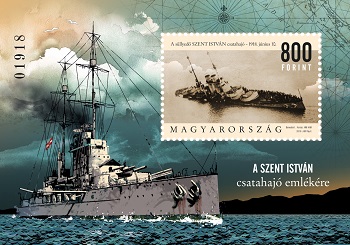
Szent István Csatahajó emlékére - Bélyegblokk
A Magyar Posta alkalmi bélyegblokk kibocsátásával emlékezik meg a SZENT ISTVÁN csatahajóról. A sorszámozott blokk Benedek Imre grafikusművész tervei szerint az ANY Biztonsági Nyomdában készült 70 000 perforált és 2000 vágott példányban. Az újdonság 2018. június 29-től kapható az elsőnapi postákon és a Filapostán, továbbá megrendelhető a Magyar Posta internetes áruházából is.
100 évvel ezelőtt az első világháború utolsó hónapjait éltük, mindkét oldal egyre elszántabban és elkeseredettebben küzdött a győzelemért. Az antant az Adriai-tengert az Otrantói-szorosnál lezárva tartotta, amivel megakadályozta, hogy a központi hatalmak hajói déli irányba kihajózhassanak a Földközi-tenger felé. Ezt a hajózárat 1917-ben egyszer már sikeresen feltörték, de az elzárást az antant ismét visszaállította.
Az 1918-ban indított új hadművelet célja – amelyben az Osztrák–Magyar Monarchia teljes flottája részt vett – az volt, hogy az Otrantói-szoros elzárását ismét feltörje és tőrbe csalja az antant adriai erőit. A hadművelet a június 9-i holdtalan éjszakán indult, amikor a Monarchia erői két csoportra osztva futottak ki a tengerre. A második csoport tagja volt a SZENT ISTVÁN csatahajó.
A magyar történelem egyetlen csatahajójának elkészítése 1912 januárjában, a fiumei Ganz Danubius hajógyárban kezdődött meg, mely munka két és fél esztendőt vett igénybe. A méreteket jól jelzi, hogy a munkálatok megkezdése előtt új sólyateret kellett építeni, mert a korábbi nem volt alkalmas ilyen hatalmas méretű – mintegy 150 méter hosszú és 20 000 tonna vízkiszorítású – hajó építésére.
A SZENT ISTVÁN volt az egyik első olyan csatahajó, amelyet tornyonként három, 305 mm-es löveggel szereltek fel. A hajó fő fegyverzetét ezek a lövegek – a négy toronyban összesen tizenkettő – alkották, de az egymás felett elhelyezett ágyútornyok itt még stabilitási problémákat okoztak. Később a háromlöveges toronyelrendezés lett a minta az amerikai haditengerészet csatahajóinál is. A két hajócsavarral rendelkező hadihajó maximális sebessége 20,4 csomó (38 km/h) volt.
Bár a hajó már 1915 novemberétől szolgálatban állt, a háború java részét Póla kikötőjében töltötte, és leeresztett horgonnyal elsősorban légvédelemi feladatokat látott el – első küldetésére egészen a már említett 1918. június 9-i éjszakáig kellett várnia. A kötelék azonban műszaki probléma miatt csak egyórás késéssel tudta elhagyni a pólai hadikikötőt, ami azt jelentette, hogy világosban is haladniuk kellett. A hajnali fényben a Monarchia hajóit két olasz tengeralattjáró-elhárító motorcsónak észrevette, meg tudták őket közelíteni, és június 10-én 3 óra 31 perckor két torpedóval sikeresen el is találták a SZENT ISTVÁN csatahajót. A detonációkat követően több órás küzdelem kezdődött a fennmaradásért, amely sajnos sikertelen volt – végül a hajó átfordult és perceken belül elsüllyedt. Legénysége 1087 főből állt, 85 matróz és 4 tiszt vesztette életét.
Ez a kudarc romba döntötte az osztrák–magyar hadiflotta utolsó, legnagyobb szabásúra tervezett tengeri hadműveletét. A SZENT ISTVÁN tragédiája után a Monarchia flottája többé már nem futott ki a tengerre.










